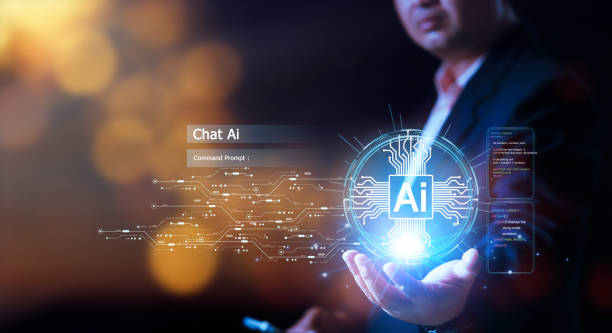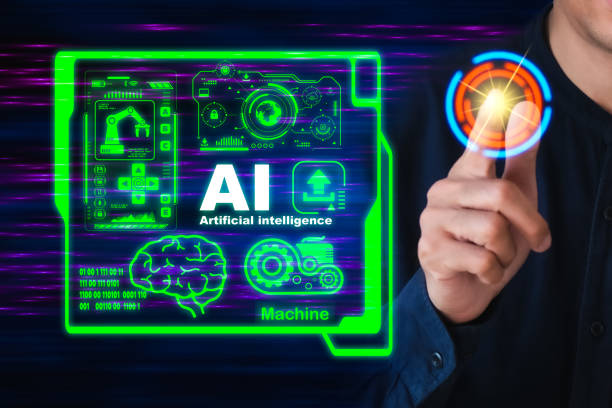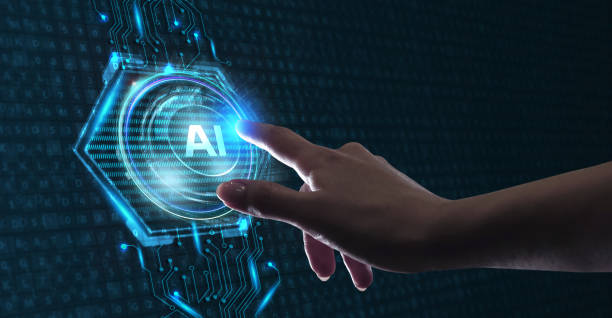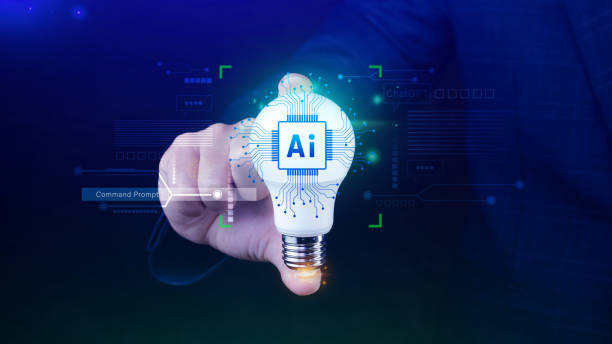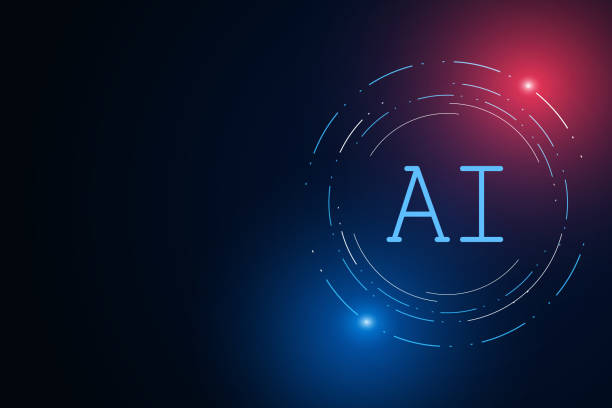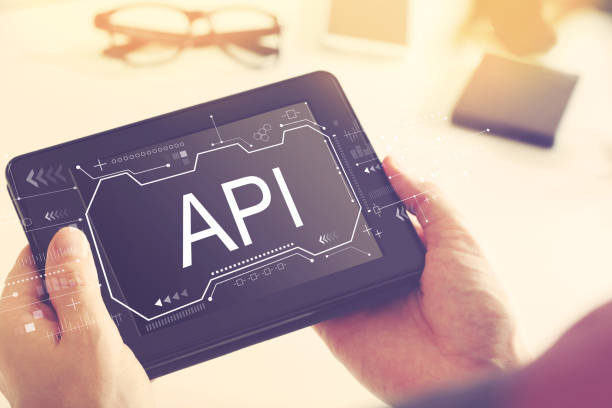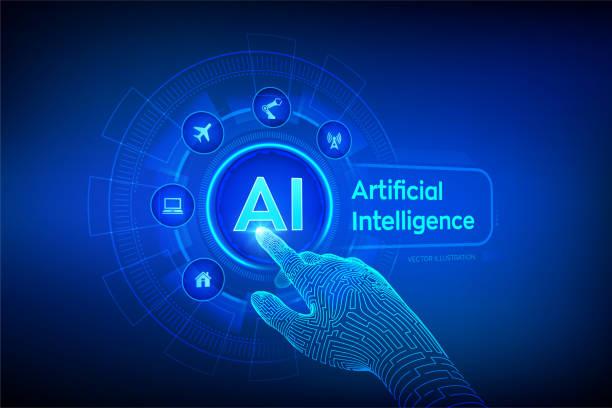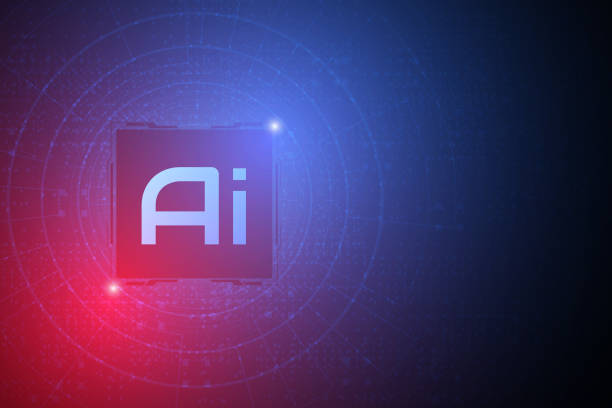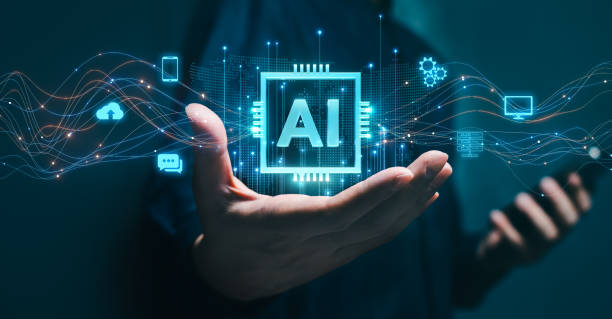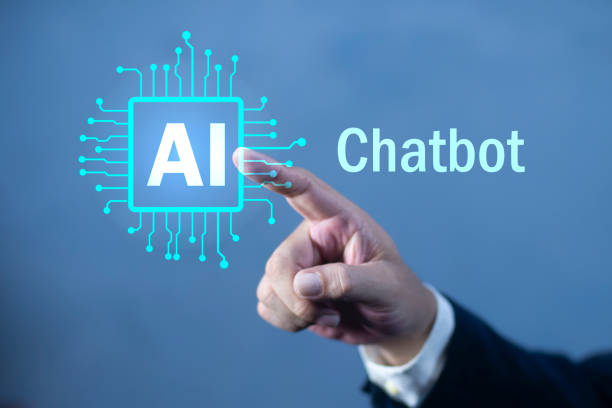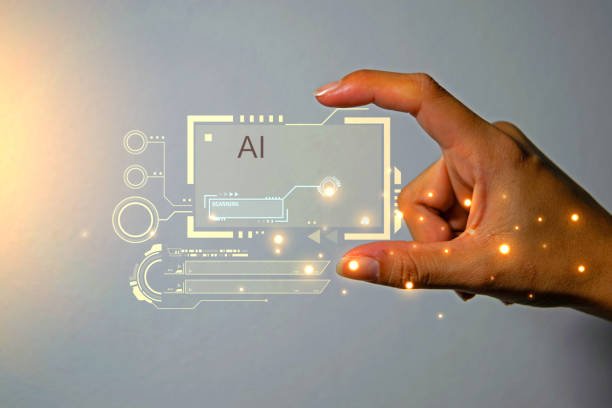What is an Artificial Intelligence Robot? Definition and Applications
An artificial intelligence robot is a combination of two attractive and practical fields: #Artificial_Intelligence and #Robotics.
Simply put, an AI robot is a robot that uses artificial intelligence algorithms to perform tasks that require human intelligence.
These tasks can include learning, reasoning, problem-solving, pattern recognition, and decision-making.
The main difference between smart robots and traditional robots is that traditional robots operate according to pre-determined programs and cannot adapt to new conditions.
In contrast, an AI robot can change and optimize its behavior using its data and experiences.
Artificial intelligence and robotics work together to create innovative solutions to complex challenges in various fields from healthcare to agriculture.
The applications of AI robots are vast and can be found in almost any industry.
Common applications include:
- Manufacturing Industry: Smart robots in production lines can perform repetitive and dangerous tasks with high accuracy and speed.
- Customer Service: Chatbots and virtual assistants can answer customer questions and solve their problems.
- Medicine: Surgical robots can perform complex surgeries with greater precision.
- Agriculture: Agricultural robots can help with harvesting, spraying, and irrigating fields.
The Internet of Things (IoT) plays a significant role in expanding the capabilities of smart robots, as it enables robots to interact with each other and their environment, and use the collected data to improve their performance.
Are you tired of losing business opportunities because you don’t have a professional company website?
Rasaweb helps you build a professional company website by:
✅ Creating a powerful and reliable image of your brand
✅ Turning website visitors into loyal customers
⚡ Get a free consultation now!
Main Components of an AI Robot: Hardware and Software Review
An AI robot consists of two main parts: hardware and software.
Hardware includes the physical components of the robot such as the body, sensors, motors, and processors.
Software includes AI algorithms and control programs that enable the robot to perform its tasks.
Click here to preview your posts with PRO themes ››
Sensors play an important role in collecting information from the environment.
There are different types of sensors that can measure information such as temperature, light, sound, image, and distance.
This information helps the robot to better understand its environment and make better decisions.
Motors are responsible for the robot’s movement.
There are different types of motors that can create different movements such as rotation, linear movement, and rotary movement.
The choice of the right motor depends on the type of task the robot has to perform.
Processors are the brain of the robot.
They process the information collected by the sensors and make decisions to control the motors.
Processors must have sufficient processing power to run complex AI algorithms.
AI robot software includes AI algorithms and control programs.
AI algorithms enable the robot to learn, reason, solve problems, and make decisions.
Control programs enable the robot to control its motors and other hardware components.
Robots AI can be programmed through graphical user interfaces (GUI) or through coding, which allows for the creation of diverse and complex applications.
Key Algorithms in AI Robots: Machine Learning and Neural Networks
Machine learning algorithms play a fundamental role in the performance of AI robots.
These algorithms allow the robot to learn from its data and experiences and improve its performance.
There are two main types of machine learning algorithms: supervised learning and unsupervised learning.
In supervised learning, the robot is trained using labeled data.
This data includes inputs and expected outputs.
By analyzing this data, the robot builds a learning model that can predict the expected outputs for new inputs.
In unsupervised learning, the robot is trained using unlabeled data.
By analyzing this data, the robot identifies hidden patterns and structures in the data.
These patterns can be used to cluster data, reduce data dimensions, and other tasks.
Click here to preview your posts with PRO themes ››
Neural networks are a type of machine learning algorithm that is inspired by the structure of the human brain.
Neural networks consist of a large number of interconnected nodes.
Each node performs a simple mathematical function.
By adjusting the weights of the connections between nodes, the neural network can learn complex patterns in the data.
TensorFlow and PyTorch are among the popular frameworks that are used to develop and implement machine learning models and neural networks.
The following table provides a comparison between supervised and unsupervised learning algorithms:
| Feature | Supervised Learning | Unsupervised Learning |
|---|---|---|
| Data Type | Labeled Data | Unlabeled Data |
| Goal | Predict Expected Outputs | Identify Patterns and Structures |
| Applications | Classification, Regression | Clustering, Dimensionality Reduction |
Challenges and Limitations of AI Robots: Obstacles Ahead
Despite significant advances in the field of AI robots, there are still challenges and limitations that prevent further expansion of this technology.
One of the most important challenges is the high cost of developing and implementing smart robots.
Designing, building, and programming AI robots require significant expertise and resources.
Another challenge is the complexity of AI algorithms.
Developing algorithms that can enable robots to perform complex tasks with high accuracy and speed requires extensive research and development.
Also, AI robots may face problems in unpredictable conditions.
They may not be able to react correctly to environmental changes and make wrong decisions.
Ethical limitations are also an important challenge in the field of AI robots.
The use of smart robots in some areas, such as military and security, may raise concerns about the privacy and security of individuals.
For example, the use of AI robots in judicial decision-making can lead to discrimination and inequality.
Security issues are also of high importance.
AI robots may be subject to cyber attacks and controlled by hackers.
This can lead to serious damage to individuals and organizations.
Finally, social acceptance of smart robots is also a challenge.
Some people may be afraid of robots or oppose their presence in their work and lives.
To overcome this challenge, it is necessary to explain the benefits of using AI robots transparently and clearly to the general public.
Does your current company website provide a worthy image of your brand and attract new customers?
If not, turn this challenge into an opportunity with Rasaweb’s professional website design services.
✅ Significantly improves your brand’s credibility and image.
✅ Smooths the path to attract new leads and customers for you.
⚡ Contact Rasaweb now to receive free and specialized consultation!
Future of AI Robots: Predicted Transformations
The future of AI robots looks very bright and promising.
With the increasing advances in the field of artificial intelligence and robotics, it is expected that smart robots will play a more prominent role in our lives.
One of the predicted transformations is the increased capabilities of AI robots.
They will be able to perform more complex tasks and interact more effectively with humans.
It is expected that in the near future, smart robots will be able to recognize human emotions and respond to them appropriately.
This could lead to the creation of companion robots and smart personal assistants that can help people with daily tasks and take care of them.
Advances in the field of deep learning and neural networks enable smart robots to learn from their data and experiences more effectively and improve their performance.
This can lead to the creation of self-learning robots that can learn new tasks without the need for manual programming.
Also, it is expected that the cost of developing and implementing AI robots will decrease.
This can lead to the expansion of the use of smart robots in various industries and in homes.
AI robots are used in various sectors, from automating processes to assisting humans in daily life.
Finally, it is expected that laws and regulations related to AI robots will be developed.
These laws can help protect the privacy and security of individuals and prevent the misuse of this technology.
The Role of AI Robots in Different Industries: Case Studies
AI robots play key roles in various industries and help improve efficiency, reduce costs, and increase safety.
In the manufacturing industry, smart robots are used in production lines to perform repetitive and dangerous tasks.
They can assemble parts with high accuracy and speed, package products, and check product quality.
In the healthcare industry, surgical robots can perform complex surgeries with greater precision.
Pharmacist robots can distribute medications with high accuracy, and nurse robots can help patients with daily tasks.
In the field of logistics, warehouse robots can collect and package goods with high speed and accuracy.
Transportation robots can deliver goods to their final destination.
In the agricultural sector, agricultural robots can help with harvesting, spraying, and irrigating fields.
They can detect the needs of plants using sensors and AI algorithms and automatically take care of them.
In the customer service industry, chatbots and virtual assistants can answer customer questions and solve their problems.
They can be available 24 hours a day, 7 days a week, and help customers anytime, anywhere.
AI robots play an important role in process automation, increasing productivity and improving the quality of services.
Training and Learning AI Robots: Available Resources and Tools
Training and learning AI robots require access to appropriate resources and tools.
Fortunately, today there are diverse educational resources available to interested individuals.
Various universities and educational institutions offer AI robot training courses at different levels.
These courses usually include topics such as the basics of artificial intelligence, machine learning, robotics, programming, and electronics.
In addition to training courses, numerous books and scientific articles have been published in the field of AI robots.
These resources can help interested individuals to gain a deeper understanding of the concepts and techniques related to this field.
Websites and online communities are also valuable resources for learning and exchanging information in the field of AI robots.
Interested individuals can ask their questions, share their experiences, and benefit from the knowledge of others on these websites and communities.
Various tools are also available for developing and implementing AI robots.
These tools include software frameworks, code libraries, and hardware platforms.
Software frameworks such as TensorFlow and PyTorch are powerful tools for developing and training machine learning models.
Code libraries such as OpenCV are tools for image processing and machine vision.
Hardware platforms such as Arduino and Raspberry Pi are tools for building and controlling robots.
The following table compares some popular hardware platforms for developing AI robots:
| Platform | Processor | Memory | Capabilities | Price |
|---|---|---|---|---|
| Arduino | AVR | 32KB | Simple control, ease of use | Cheap |
| Raspberry Pi | ARM | 1GB+ | Image processing, machine learning | Medium |
| NVIDIA Jetson | ARM + GPU | 4GB+ | Advanced image processing, deep learning | Expensive |
AI Robots in Iran: Current Status and Outlook
The field of AI robots is also growing and developing in Iran.
Numerous universities and research institutions in Iran are active in the field of robotics and artificial intelligence.
Iranian students and researchers in this field have published numerous scientific articles in international journals and conferences and have won numerous awards.
Numerous knowledge-based companies in Iran are also active in the field of manufacturing and developing smart robots.
These companies produce robots for various applications such as industry, agriculture, medicine, and customer service.
The Iranian government also supports the development of AI robots.
Numerous programs are being implemented to support knowledge-based companies and develop new technologies in Iran.
The outlook for AI robots in Iran is very bright and promising.
Given the scientific and technological capabilities available in the country, it is expected that Iran will become one of the leading countries in the field of robotics and artificial intelligence in the near future.
AI robots can play an important role in the country’s economic development by assisting various industries.
Also, the use of AI robots in education can help improve the quality of education in the country.
Educational robots can help students learn complex concepts and prepare them for entering the job market.
Are you losing potential customers due to a non-professional website? Rasaweb is your answer! With our specialized company website design services:
✅ Enhance the credibility and position of your business
✅ Experience attracting more targeted customers
⚡ Take action now to receive free consultation!
Ethical Considerations in the Development and Use of AI Robots
The development and use of AI robots require attention to ethical considerations.
Smart robots can have profound impacts on society, and it is necessary to prevent the misuse of this technology.
One of the most important ethical considerations is protecting the privacy of individuals.
Smart robots can collect a lot of information about individuals, and it is necessary to protect this information properly.
Accountability is also an important ethical consideration.
If a smart robot makes a wrong decision and harms someone, who will be responsible? It is necessary to develop laws and regulations to determine responsibility in these cases.
Transparency is also of high importance.
It is necessary to explain the performance of smart robots transparently and clearly to the general public.
Justice is also an important ethical consideration.
Smart robots should not be discriminatory and should treat all individuals fairly.
Safety is also of high importance.
Smart robots should not be used for malicious purposes.
AI robots can be used in various sectors, but it is necessary to always observe ethical considerations.
Also, it is necessary to discuss and exchange views on the impact of smart robots on employment.
Smart robots may cause the loss of some jobs, and it is necessary to consider solutions to deal with this problem.
How to Build an AI Robot: A Step-by-Step Guide
Building an AI robot can be an exciting and challenging project.
To start, you must first have an idea for your robot.
What task do you want your robot to perform? After the idea is clear, you must prepare the required hardware and software components.
Hardware components include the robot body, sensors, motors, and processors.
Software components include AI algorithms and control programs.
After preparing the hardware components, you must connect them together and build the robot body.
Then, you must implement AI algorithms and write control programs.
To implement AI algorithms, you can use software frameworks such as TensorFlow and PyTorch.
To write control programs, you can use programming languages such as Python and C++.
After implementing the algorithms and writing the programs, you must run them on your robot and test its performance.
If necessary, you can improve the algorithms and programs to optimize the robot’s performance.
Robotics Association is a non-profit organization that provides valuable information about robotics and automation.
Finally, remember that building an AI robot is an iterative process.
You may need to repeat the design, construction, and testing steps several times to achieve the desired result.
Be patient and learn from your mistakes.
In order to be more successful in this project, it is recommended to be familiar with the basics of electronics, programming, and mechanics.
Frequently Asked Questions
| Question | Answer |
|---|---|
| What is an AI Robot? | It is a robot that uses artificial intelligence capabilities to understand the environment, reason, learn, and make decisions to perform complex tasks independently. |
| What is the main difference between a regular robot and an AI robot? | AI robots can learn and adapt to their environment, while regular robots usually operate based on fixed and pre-determined programming. |
| In what areas are AI robots used? | In areas such as industry (production lines), medicine (robotic surgeries), services (customer support, smart vacuum cleaners), exploration (space and underwater), and entertainment. |
| How do AI robots learn? | They acquire new skills through machine learning (ML) and deep learning algorithms, by analyzing big data and identifying patterns. |
| Can AI robots have emotions? | Currently, no. They can identify or simulate emotions, but they do not have a real experience of emotions like humans. |
| What are the most important benefits of using AI robots? | Increased productivity, reduced human error, performing dangerous or repetitive tasks, and providing innovative and efficient services. |
| What challenges exist in the development of AI robots? | The need for abundant and high-quality data, the complexity of algorithms, ethical issues, cybersecurity, and the high cost of research and development. |
| Are AI robots dangerous to humans? | By following safe design principles and ethical regulations, no. Concerns are more related to social and economic impacts such as changes in the labor market. |
| What is an example of an AI robot in everyday life? | Smart vacuum cleaners (such as Roomba) that automatically map and clean the house, or smart voice assistants (such as Siri and Alexa). |
| How is the future of AI robots predicted? | They are expected to become smarter, more autonomous, and capable of more complex interactions with humans, and play a more prominent role in industry, medicine, transportation, and everyday life. |
And other services of Rasa Web advertising agency in the field of advertising
Smart Marketplace: A fast and efficient solution to attract customers with a focus on attractive user interface design.
Smart Sales Automation: A creative platform to improve customer behavior analysis with accurate audience targeting.
Smart Customer Journey Map: A creative platform to improve campaign management with marketing automation.
Smart Customer Journey Map: A fast and efficient solution to increase sales with a focus on custom programming.
Smart Conversion Rate Optimization: A fast and efficient solution for digital branding with a focus on SEO-driven content strategy.
And more than hundreds of other services in the field of internet advertising, advertising consulting and organizational solutions
Internet Advertising | Advertising Strategy | Advertorial Report
Sources
The Future of Artificial Intelligence in the Job Market
,What is Artificial Intelligence and How Does it Work?
,How Artificial Intelligence Can Transform All Aspects of Our Lives
,Artificial Intelligence from a Tourist Perspective to Widespread Increase; Why Should Artificial Intelligence Be Controlled?
? In Rasa Web Digital Marketing Agency, your digital dreams come true with our expertise. From professional SEO optimization to secure website design and creative advertising campaigns, we are your partner in the digital world.
📍 Tehran, Mirdamad Street, next to the Central Bank, South Kazerun Alley, Ramin Alley No. 6


